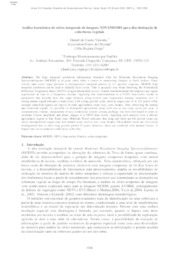Análise harmônica de séries temporais de imagens NDVI/MODIS para discriminação de coberturas vegetais.
Análise harmônica de séries temporais de imagens NDVI/MODIS para discriminação de coberturas vegetais.
Author(s): VICTORIA, D. D. C.; OLIVEIRA, A. F. D.; GREGO, C. R.
Summary: The high temporal resolution information obtained with the Moderate Resolution Imaging Spectroradiometer (MODIS) is of great value when it comes to monitoring changes in Earth surface. Since several land cover types presents a distinguished temporal pattern in it?s spectral response, MODIS high temporal resolution can be used to identify such covers. This is specially true when observing the Normalized Difference Vegetation Index (NDVI) of agricultural land covers. Fourier transformations decomposes any signal represented in time to a frequency domain. Applying this transformation in a NDVI time-series results in parameters that describe how this signal behaves along several time frequencies (annual, semestral, etc). A strong annual signal indicates a land cover with a long growth cycle, such as sugar-cane (1 to 1.5 years) while stronger semestral signals are typical of other agricultural crops (soy, corn, beans). Also, observing the annual and semestral signals, it?s possible to distinguish agricultural areas with one or two crop cycles per year. A computational routine, independent of any commercial remote sensing package, has been developed in order to calculate Fourier amplitude and phase images of a NDVI time series. Applying such analysis over a diverse agricultural region in São Paulo state (Ribeirão Preto) indicates that long and short growth period crops are easily distinguished (sugar-cane and annual crops such as soy, corn, beans). Silvicultural areas are also easily distinguished due to their long growth period (5 years) however, these are confused with natural forests. A longer time series analysis could easily solve this.
Publication year: 2009
Types of publication: Paper in annals and proceedings
Unit: Embrapa Territorial
Keywords: Fourier, MODIS, NDVI, Series temporais, Time series
Observation
Some of Embrapa's publications are published as ePub files. To read them, use or download one of the following free software options to your computer or mobile device. Android: Google Play Books; IOS: iBooks; Windows and Linux: Calibre.
Access other publications
Access the Agricultural Research Database (BDPA) to consult Embrapa's full library collection and records.
Visit Embrapa Bookstore to purchase books and other publications sold by Embrapa.

